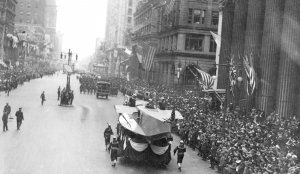President Donald Trump declared a national emergency in the United States on March 13, 2020 due to the mass outbreak of Covid-19.4 While unexpected, this is not the first time the United States has been faced with a pandemic. Prior to 2020, one of the most notable pandemics within fairly recent American history was the 1918 influenza pandemic. Anna Dhody, a curator at the Mütter Museum in Philadelphia, sat with mortician Caitlin Doughty back in late 2019 to discuss how Philadelphia handled the 1918 pandemic and how prepared the country would be to experience another pandemic. This resource not only explains the struggles Philadelphia faced during the 1918 influenza pandemic and how it correlates to modern times, but does so in an unexpectedly light hearted way that makes a rather somber topic a little less heavy. This is an image of the 1918 Fourth Liberty Loan Parade in Philadelphia just prior to the outbreak of influenza.
This is an image of the 1918 Fourth Liberty Loan Parade in Philadelphia just prior to the outbreak of influenza.
The main focus of this discussion was how Philadelphia dealt with the very sudden and very large number of deaths related to the influenza outbreak. Philadelphia was one of the hardest hit American cities during the 1918 pandemic, making it a good resource to reference when preparing for future health crises. This deadly influenza breakout was thought to have started after the Fourth Liberty Loan Parade, which was meant to boost morale and in support of World War I.2 Within 72 hours of this gathering of approximately 200,000 people, every hospital bed in Philadelphia had been filled and after only one week over 2,500 people had already succumbed to the flu or complications from it.3 Not only was the city dealing with a health crisis and overflowing hospitals, but now had the pressing matter of a large number of deaths that the funeral industry in Philadelphia could handle.

When looking at the 2020 Covid-19 pandemic it is clear that we have come a long way as far as our knowledge of public health crises, as well as the technology and resources we have to deal with them. Prior to the current pandemic of 2020 author and mortician Caitlin Doughty touched on one issue that we may not have figured out since the 1918 pandemic, which is how to handle a large, possibly unexpected, number of fatalities. This was a particularly difficult task in 1918 as the country was already dealing with the effects of World War I, meaning there were fewer men to dig graves and run the death industry. While we do have newer technology such as more accessible refrigeration and DMORT, which is a resource to help handle mass fatalities, many areas would not have enough of these resources to manage a sudden large scale surge in deaths. In terms of technology, Doughty mentions that cremation would now be an alternative resource to help with these issues as it was not an option in 1918, though a standard industrial cremation machine can still only handle about 12 cremations a day.2
In an update after the 2020 pandemic began, Doughty discussed how death related to the coronavirus was being dealt with in one of the virus hot spots, New York City. Her main criticism of the process was the influence of the media quoting a tweet sent out by New York City Councilman Mark Levine stating, “Soon we’ll start ‘temporary interment’. This likely will be done by using a NYC park for burials”.1 While this statement was part of a multilevel plan to prepare New York City for the worst case scenario that would most likely never actually happen, the media ran with it and began spreading misinformation. Another issue Doughty touched on aligned with what she had predicted to be an issue in a future pandemic, which is the lack of resources needed to care for the deceased, primarily refrigeration and crematories. This shows that despite pandemics being relatively uncommon occurrences, we should take the time to examine events such as the influenza pandemic of 1918 to better understand and anticipate possible problems before they become reality.
For more information on the 1918 Influenza Pandemic:
The Mütter Museum Spit Spreads Death: The Influenza Pandemic of 1918-19 in Philadelphia

Hi Nicole,
What a heartbreaking time we are in right now. I doubt anyone thought this would go on this long, especially because as you point out, we have advanced immensely in terms of resources and technology to handle outbreaks of contagious diseases. This was a great post to highlight the fact that although we have come a long way, we still have so much to learn from historical events like the flu outbreak in 1918. You also bring up a good point about being skeptical of the media and the danger “fake news” and misinformation can bring to everyone. When I think of the media’s role in reporting on COVID, I don’t know whether to be scared, trusting, or really what to feel. This was a great post that emphasizes the importance of historical evidence as well as the evaluation of sources- two crucial skills students will need to master!